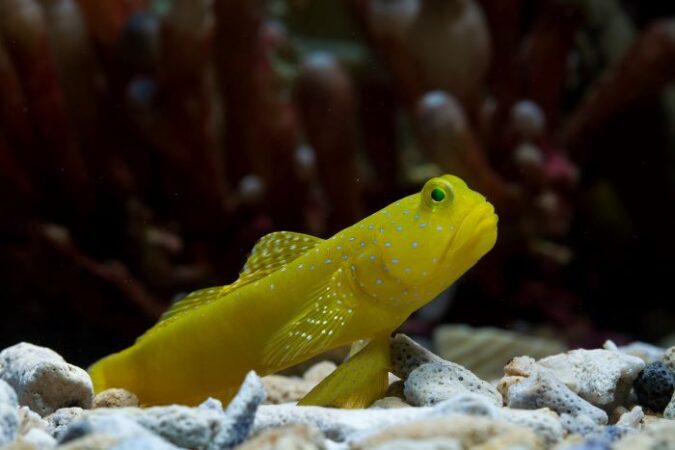The vibrant yellow watchman goby (Cryptocentrus cinctus) is a popular saltwater aquarium fish that originates from the reefs of the Indo-Pacific Ocean region. When provided proper care, the yellow watchman goby can live up to 10 years in a home saltwater tank. But what exactly are the signs of a happy and healthy watchman goby? Read on for a detailed overview.
Table of Contents
What is a Yellow Watchman Goby?
The yellow watchman goby gets its name from its bright yellow head and body and its behavior of standing guard over its burrow, keeping watch for threats. They have an elongated body reaching 4-5 inches long and feature large eyes and two dorsal fins. Watchman gobies are peaceful bottom dwellers but require plenty of rocky crevices and burrows in the sand bed to feel secure. They also form a close symbiotic pairing with pistol shrimps who maintain the shared burrow.
Sign #1 – Vibrant Coloration
The first key sign of health is vibrant yellow coloration with no darkening or dullness. Both the head and body should appear uniformly and intensely yellow with perhaps some black spotting on the rear dorsal fin. The yellow pigments stem from quality nutrition so dull color usually indicates poor diet. Providing meaty foods like vitamin-enriched brine shrimp maintains ideal color pop.
Sign #2 – Clear, Intact Fins
All of the watchman goby’s fins should appear fully intact and unfrayed. That includes the two dorsal fins reaching down its back, the caudal (tail) fin spreading from the backside, the anal fin on the underside behind the anus, and the pectoral fins on either side of the gills. Fins are highly vascularized tissues requiring nutrients and oxygen. Rapid fin regeneration also demands high energy. Tattered, damaged fins therefore signal stress, disease, or aggression from tankmates.
Sign #3 – Respiration Without Effort
Carefully observe the goby’s respiration pattern at rest. Breathing should appear smooth and effortless with no rapid gill movement or gulping at the surface for air. Labored breathing could indicate poor water quality, insufficient oxygenation, or respiratory infection, while gasping at the surface spells critical issues like suffocating hypoxia. Ideal respiration means all essential gases are being efficiently exchanged.
Sign #4 – Regular Bowel Movements
Feeding frequency and characteristics of waste matter offer insight on internal health. Offer foods daily in variety and modest portions, being careful not to overfeed. Watch that the goby regularly passes normal brown-colored feces to avoid intestinal issues. Stringy, excessively pale feces or constipation signal potential parasite infection or internal blockages requiring medication.
Sign #5 – Interactive & Exploratory
A healthy watchman goby actively emerges from its burrow periodically to swim about and explore its surroundings. It forages for bits of food amid rockwork and investigates tankmates without shying away or hiding excessively. Sitting motionless in one spot or cowering in the burrow suggests chronic stress, bullying, poor water chemistry, or sickness. An active fish is almost always a healthy fish!
Sign #6 – Full, Plump Body
Closely examine body shape and proportions when the watchman goby is swimming fully extended. The abdomen should appear rounded and full but not distended or swollen. An overly skinny fish probably struggles with catching prey or competing for food against faster tankmates. Internal parasites can also leach nutrients causing emaciation. Appropriate feeding frequency promotes a streamlined yet muscular figure.
Sign #7 – Intact Slime Coat
A healthy slime coat or mucus layer protects against abrasions, bacteria, and parasites. Injuries or salt level fluctuations degrade the slime coat’s integrity. Therefore, inspect the body for signs of damage to skin or protective mucus. Reddening, swelling, white grainy patches and lesions all represent concerning disruptions needing prompt treatment. Only a smooth, blemish-free exterior represents good slime coat health.
Sign #8 – Strong Burrow Association
While shy and cautious by nature, the watchman goby should retain a strong affiliation with its burrow and pistol shrimp partner. It may peer out warily when you approach but shouldn’t flee in panic. If threatened, it should rapidly disappear into its secure den. A watchman goby hiding perpetually while abandoning its burrow means its feeling endangered and stressed by suboptimal tank conditions or aggressors. The burrow reliance signals safety and security in its environment.
In Summary
When starting with an acclimated, disease-free yellow watchman goby showing clear eyes, sharp alertness, and balanced swimming, positive gains in health should continue given proper husbandry. Monitoring color, fins, respiration, appetite, activity level, body condition, slime coat quality, and burrow behavior provides key insight on sustained wellbeing. At the first signs of deterioration – address issues swiftly by testing water parameters, reducing aggressors/predators, and providing medical treatment as warranted. Invest diligently in your goby’s care and it will reward you with vibrant color displays, fascinating behaviors, and years of aquatic enjoyment!






I am really impressed with your writing talents as smartly as with the layout to your blog. Is that this a paid subject matter or did you customize it yourself? Either way stay up the nice quality writing, it is rare to look a nice blog like this one these days!